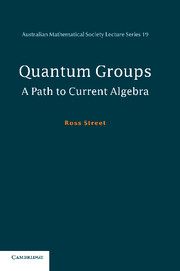Book contents
- Frontmatter
- Contents
- Introduction
- 1 Revision of basic structures
- 2 Duality between geometry and algebra
- 3 The quantum general linear group
- 4 Modules and tensor products
- 5 Cauchy modules
- 6 Algebras
- 7 Coalgebras and bialgebras
- 8 Dual coalgebras of algebras
- 9 Hopf algebras
- 10 Representations of quantum groups
- 11 Tensor categories
- 12 Internal homs and duals
- 13 Tensor functors and Yang–Baxter operators
- 14 A tortile Yang–Baxter operator for each finite–dimensional vector space
- 15 Monoids in tensor categories
- 16 Tannaka duality
- 17 Adjoining an antipode to a bialgebra
- 18 The quantum general linear group again
- 19 Solutions to Exercises
- References
- Index
Introduction
Published online by Cambridge University Press: 15 December 2009
- Frontmatter
- Contents
- Introduction
- 1 Revision of basic structures
- 2 Duality between geometry and algebra
- 3 The quantum general linear group
- 4 Modules and tensor products
- 5 Cauchy modules
- 6 Algebras
- 7 Coalgebras and bialgebras
- 8 Dual coalgebras of algebras
- 9 Hopf algebras
- 10 Representations of quantum groups
- 11 Tensor categories
- 12 Internal homs and duals
- 13 Tensor functors and Yang–Baxter operators
- 14 A tortile Yang–Baxter operator for each finite–dimensional vector space
- 15 Monoids in tensor categories
- 16 Tannaka duality
- 17 Adjoining an antipode to a bialgebra
- 18 The quantum general linear group again
- 19 Solutions to Exercises
- References
- Index
Summary
Algebra has moved well beyond the topics discussed in standard undergraduate texts on “modern algebra”. Those books typically dealt with algebraic structures such as groups, rings and fields: still very important concepts! However, Quantum Groups: A Path to Current Algebra is written for the reader at ease with at least one such structure and keen to learn the latest algebraic concepts and techniques.
A key to understanding these new developments is categorical duality. A quantum group is a vector space with structure. Part of the structure is standard: a multiplication making it an “algebra”. Another part is not in those standard books at all: a comultiplication, which is dual to multiplication in the precise sense of category theory, making it a “coalgebra”. While coalgebras, bialgebras and Hopf algebras have been around for half a century, the term “quantum group”, along with revolutionary new examples, was unleashed on the mathematical community by Drinfel'd [Dri87] at the International Congress in 1986. Before launching into an explanation of the duality required, I should mention here that an ordinary group gives rise to a quantum group by taking the vector space with the group as basis.
When pushed to provide formal proofs of our claims, mathematicians generally resort to set theory. We build our structures on sets and feel satisfied when we can be explicit about the elements of our constructed objects. Up to the mid twentieth century, algebraic objects were sets with selected operations which assigned elements to lists of elements. Typically, we would have binary operations which might be called addition, multiplication or Lie bracket respectively assigning a sum, product or formal commutator to each pair of elements.
- Type
- Chapter
- Information
- Quantum GroupsA Path to Current Algebra, pp. ix - xviiiPublisher: Cambridge University PressPrint publication year: 2007

